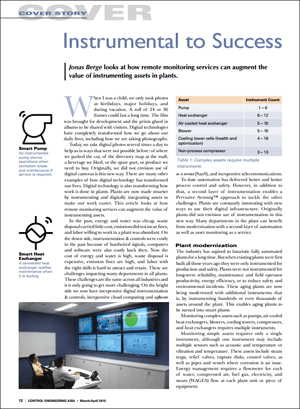Yesteryear, energy and water were relatively inexpensive, waste disposal carried little cost, emissions did not incur fines and people willing to work in harsh manufacturing plant and production facility environments were abundant. Today, energy and water costs are high, waste disposal is expensive, emission fines are high, and people with the right skills to work in these facilities are more difficult to find and keep.
 Emerson’s Jonas Berge makes these observations in a Control Engineering Asia article, Instrumental to Success. He highlights how the prior environment impacted the way plants and production facilities were instrumented:
Emerson’s Jonas Berge makes these observations in a Control Engineering Asia article, Instrumental to Success. He highlights how the prior environment impacted the way plants and production facilities were instrumented:
But when existing plants were first built all those years ago they were only instrumented for production and safety. Plants were not instrumented for long-term reliability, maintenance and field operator productivity, energy efficiency, or safety and environmental incident monitoring.
Given the demands of today, adding more sensing devices is critical to address these challenges. Jonas makes the analogy of how digital pictures have transformed the way we do things. Where in the film era, pictures were for special occasions, today they are used for many things:
…where we parked the car, of the directory map at the mall, a beverage we liked, or the spare part, or produce we need to buy.
Similarly, additional sensing devices beyond basic process control and safety shutdown open up new opportunities never before envisioned. Using wireless sensors to monitor simple safety devices is one example:
These assets include steam traps, relief valves, rupture disks, control valves, as well as pipes and vessels where corrosion is an issue.
Early detection of problems can avoid unplanned downtime, abnormal situations, and quality and reliability issues.
Another example is adding flowmeters to measure water, compressed air, fuel gas, electricity and steam (WAGES) to measure and optimize energy usage. Jonas cites other ways to improve energy efficiency through wireless acoustic devices to monitor leaks in steam traps and relief valves.
He notes how these additional sensors can change work practices:
With permanently installed vibration, temperature, and acoustic transmitters plants gain the ability to reduce maintenance rounds and instead assign personnel to service the equipment that really needs attention, before they fail catastrophically. Arrays of instruments mounted on processing equipment in conjunction with asset management software or add-on applications to the historian which plants already have give the ability to detect impending problems early so equipment can be serviced before a failure causes costly process downtime or slowdown.
This additional instrumentation also opens up the opportunity for expertise in remote locations to monitor and work with the local plant to keep the process running smoothly.
You’ll want to read the article for other examples of improving performance through continuous monitoring of pumps, heat exchangers, compressors, blowers, cooling towers, safety showers, storage tanks, and gauge replacements.
Jonas concludes:
Existing plants can be modernized with additional instrumentation. For a new plant, this should be planned from the very beginning of a project. With the increasing demand for reliability, energy efficiency, and from new environmental and safety regulations plant personnel are unable to cope unless they are given better tools.
Instrumenting equipment feeding data into new software tools now makes sense. By automatic condition monitoring for assets as small as a steam trap, thousands of healthy assets can be ruled out, and personnel can instead focus their attention on the assets that really need service. A Pervasive Sensing strategy is instrumental to success.
You can connect and interact with other reliability and wireless experts in the Reliability & Maintenance and Wireless groups in the Emerson Exchange 365 community.





